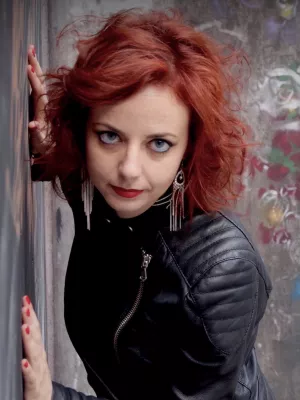
Felicita Brusoni
Doctoral student

A Voice Beyond the Edge: Michael Edgerton's "Anaphora" : Nonlinear dynamics in the extra-normal voice
Author
Summary, in English
Perhaps a few words on Anaphora would be relevant at this point. This composition aims to list nonstandard vocal gestures, which are categorized according to the degree of voicing present as either voiced or unvoiced. Subsequently all of the voiced/unvoiced alternatives are combined to form larger meta-sonorities so that we hear voiced & voiced sounds, voiced & unvoiced sounds, unvoiced & unvoiced sounds, and three or more elements. Additionally, Edgerton was doing research on bioacoustics and physics looking at the dynamics of the voice, not in terms of sound level, but of system function. These nonlinear aspects discussed in scientific literature are integrated into Anaphora. In my presentation and performance I will discuss the importance of nonlinear dynamics that form the foundation for nonlinear vocal phenomena, which are seen as vocal behaviors that deviate from normal periodic phonation, or as many objects that were formerly considered extraneous acoustically, aesthetically and physiologically when compared to melodic singing.
Extended vocal techniques have been around for the last 60 years, thanks to vocal pioneers famous for their determination to cross boundaries. But now, thanks to new tools from acoustics and medical imaging, we have the possibility to scientifically study and codify issues surrounding the sound production of phenomena ranging from multiphonics to biphonation to deterministic chaos.
Another major theme of my research will focus on codification; not only in terms of notation, but also of finding a unilateral stock of knowledge useful for both composers and performers, thanks to scientific demonstration. To codify the extended techniques for voice also means to find a way to study them, to repeat them easily, in short to put the 21st century voice at the same level as other instruments, if we talk about nonlinear phenomena. Thanks to previous research, we now know that singers with a proper training are able to use nonlinear vocal phenomena intentionally, which means that they are able to control the recurrent production of complex sonorities.
Such research is deeply indebted to Edgerton’s book “The 21st-Century Voice”, which may be considered as the foundation stone in this field. It establishes the methodologies of codification and divulgation of the vocal techniques, and should therefore have the same importance in its field as Daniel Kientzy’s sax method or Robert Dick and Pierre-Yves Artaud’s flute method.
Furthermore, a performer is also a link between composers and audiences: what better way could a revolutionary piece as Anaphora have found to reveal Edgerton’s innovations than through public performance? A further purpose of my artistic research is to link the many different studies that investigate non-normal vocal techniques, including studies from the medical field. Then, in order to make visible our findings, to bring the various materials (recordings, scores and videos of artistic and pathological voice) together into an archive, both online and physical, based at the Malmö Academy of Music in Sweden, to make the future of extra-normal voice accessible to anyone interested.
I would like Edgerton’s piece Anaphora to be considered not only as a fundamental piece for contemporary singing, which has been compared to Berio’s Sequenza III, but most of all as the starting point of my research focused on the boundaries of the safety zone of voice.
Department/s
- Teachers (Malmö Academy of Music)
Publishing year
2021-09-01
Language
English
Document type
Conference paper: abstract
Topic
- Music
Conference name
Felicita Brusoni performance & discussion of Anaphora during PhD conference "Doctors in Performance" in Tallinn
Conference date
2021-09-01 - 2021-09-03
Conference place
Tallinn, Estonia
Status
Published